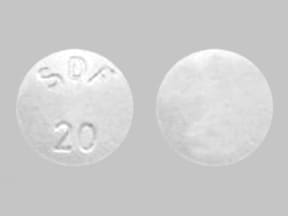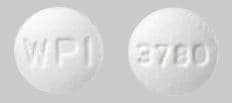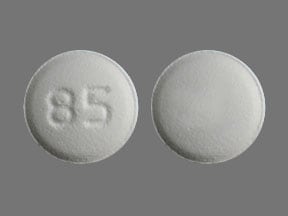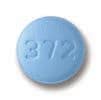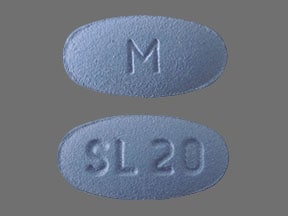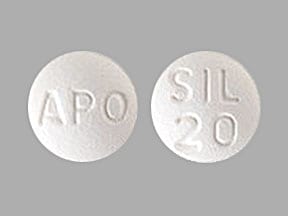Dosage Forms
Excipient information presented when available (limited, particularly for generics); consult specific product labeling.
Solution, Intravenous:
Revatio: 10 mg/12.5 mL (12.5 mL)
Generic: 10 mg/12.5 mL (12.5 mL)
Suspension Reconstituted, Oral:
Revatio: 10 mg/mL (112 mL) [contains sodium benzoate; grape flavor]
Generic: 10 mg/mL (112 mL)
Tablet, Oral:
Revatio: 20 mg
Viagra: 25 mg, 50 mg, 100 mg [contains fd&c blue #2 aluminum lake]
Generic: 20 mg, 25 mg, 50 mg, 100 mg
Pharmacology
Mechanism of Action
Erectile dysfunction: Does not directly cause penile erections but affects the response to sexual stimulation. The physiologic mechanism of erection of the penis involves release of nitric oxide (NO) in the corpus cavernosum during sexual stimulation. NO then activates the enzyme guanylate cyclase, which results in increased levels of cyclic guanosine monophosphate (cGMP), producing smooth muscle relaxation and inflow of blood to the corpus cavernosum. Sildenafil enhances the effect of NO by inhibiting phosphodiesterase type 5 (PDE-5), which is responsible for degradation of cGMP in the corpus cavernosum; when sexual stimulation causes local release of NO, inhibition of PDE-5 by sildenafil causes increased levels of cGMP in the corpus cavernosum, resulting in smooth muscle relaxation and inflow of blood to the corpus cavernosum; at recommended doses, it has no effect in the absence of sexual stimulation.
Pulmonary arterial hypertension (PAH): Inhibits phosphodiesterase type 5 (PDE-5) in smooth muscle of pulmonary vasculature where PDE-5 is responsible for the degradation of cyclic guanosine monophosphate (cGMP). Increased cGMP concentration results in pulmonary vasculature relaxation; vasodilation in the pulmonary bed and the systemic circulation (to a lesser degree) may occur.
Pharmacokinetics/Pharmacodynamics
Absorption
Rapid; slower with a high-fat meal; tablet and suspension are bioequivalent
Distribution
Vd total: Neonates: 22.4 L (or 456 L/70 kg) (Mukherjee 2009)
Vdss: Adults: 105 L
Metabolism
Hepatic via CYP3A4 (major) and CYP2C9 (minor route); major metabolite (UK-103320 or desmethylsildenafil) is formed via N-desmethylation pathway and has 50% of the activity as sildenafil
Excretion
Feces (~80%, as metabolites); urine (~13%)
Clearance: Decreased in patients with hepatic cirrhosis or severe renal impairment; clearance may be lower in patients with PAH compared to normal volunteers. Sildenafil clearance in newborns is significantly decreased compared to adults, but approaches adult (allometrically scaled) values by the first week of life (Mukherjee, 2009). Clearance of N-desmethyl active metabolite is decreased in patients with severe renal impairment.
Onset of Action
Onset: Erectile dysfunction: ~60 minutes; Peak effect: Decrease blood pressure: Oral: 1 to 2 hours
Time to Peak
Oral: Fasting: 30 to 120 minutes (median 60 minutes); delayed by 60 minutes with a high-fat meal
Duration of Action
Erectile dysfunction: 2 to 4 hours; Decrease blood pressure: <8 hours
Half-Life Elimination
Sildenafil: Terminal:
Neonates: PNA 1 day: 55.9 hours (Mukherjee 2009)
Neonates: PNA 7 days: 47.7 hours (Mukherjee 2009)
Adults: 4 hours
Active N-desmethyl metabolite: Terminal:
Neonates: 11.9 hours (Mukherjee 2009)
Adults: 4 hours
Protein Binding
Neonates: Sildenafil: 93.9% ± 2.5%; N-desmethyl metabolite: 92% ± 3% (Mukherjee 2009)
Adults: Sildenafil and N-desmethyl metabolite: ~96%
Use in Specific Populations
Special Populations: Renal Function Impairment
Severe renal impairment is associated with increased plasma levels.
Special Populations: Hepatic Function Impairment
Hepatic impairment is associated with increased plasma levels.
Special Populations: Elderly
Age 65 years or older is associated with increased plasma levels.
Use: Labeled Indications
Erectile dysfunction: Viagra: Treatment of erectile dysfunction.
Pulmonary arterial hypertension: Revatio: Treatment of pulmonary arterial hypertension (WHO group I; efficacy established predominately in patients with WHO/NYHA functional class II and III) in adults to improve exercise ability and delay clinical worsening.
Use: Off Label
High-altitude pulmonary edemayes
Based on the 2019 Wilderness Medical Society consensus guidelines for the prevention and treatment of acute altitude illness, sildenafil is a recommended option for the prevention and treatment of high-altitude pulmonary edema (as an adjunct to descent, oxygen, or portable hyperbaric therapy). Supplemental oxygen and descent are the mainstays of treatment. For prevention, sildenafil should only be considered for patients with a history of high-altitude pulmonary edema, especially multiple episodes.
Raynaud phenomenonb
Data from a meta-analysis and small controlled trials support the use of sildenafil for Raynaud phenomenon related to systemic sclerosis, demonstrating a decrease in the frequency and severity of attacks
Contraindications
Hypersensitivity to sildenafil or any component of the formulation; concurrent use (regularly/intermittently) of organic nitrates in any form (eg, nitroglycerin, isosorbide dinitrate); concomitant use of riociguat (a guanylate cyclase stimulator).
According to the manufacturers of protease inhibitors (atazanavir, darunavir, fosamprenavir, indinavir, lopinavir/ritonavir, nelfinavir, ritonavir, saquinavir, tipranavir): Concurrent use with a protease inhibitor regimen when sildenafil is used for pulmonary artery hypertension.
Canadian labeling: Additional contraindications (not in US labeling):
Viagra: Prior episode of non-arteritic anterior ischemic optic neuropathy (NAION).
Revatio: Prior episode of non-arteritic anterior ischemic optic neuropathy (NAION); concurrent use with potent CYP3A4 inhibitors (eg, ketoconazole, itraconazole, ritonavir); pulmonary hypertension secondary to sickle cell anemia; severe hepatic impairment; recent history of stroke or MI, or life-threatening arrhythmia; coronary artery disease causing unstable angina; severe hypotension (<90/50 mm Hg) at initiation.
Dosage and Administration
Dosing: Adult
Note: Contraindicated in patients taking nitrates (regularly or intermittently) due to potentially severe hypotension. If a patient taking sildenafil develops chest pain, delay therapy with a nitrate for 24 hours. For patients taking an alpha-blocking antihypertensive agent, use sildenafil with caution and consider a lower starting dose, as sildenafil can potentiate hypotensive effects (Khera 2019); some experts recommend against routinely using these drugs together, particularly in patients with cardiovascular disease (Sauer 2019).
Erectile dysfunction: Oral: 50 mg once daily as needed 1 hour before sexual activity; may be taken up to 4 hours before sexual activity. Reduce to 25 mg once daily if side effects occur. May increase to a maximum dose of 100 mg once daily if there is incomplete response.
High-altitude pulmonary edema (adjunctive therapy) (alternative agent) (off-label use):
Prevention: Note: May use sildenafil as an adjunct to gradual ascent in high-risk individuals (eg, history of high-altitude pulmonary edema or other predisposing factors) (WMS [Luks 2019]).
Oral: 50 mg every 8 hours starting the day of ascent; continue for 3 to 5 days after reaching maximal altitude (Gallagher 2019); can extend for up to 7 days in individuals who ascend faster than recommended (WMS [Luks 2019]).
Treatment: Note: Adjunctive therapy to nonpharmacologic measures (eg, oxygen supplementation, portable hyperbaric chamber, gradual descent) or as monotherapy if nonpharmacologic measures are not possible (WMS [Luks 2019]).
Oral: 50 mg every 8 hours (WMS [Luks 2019]).
Pulmonary arterial hypertension: Note: A clinician with expertise in pulmonary arterial hypertension should be consulted for all management decisions. Sildenafil is contraindicated in patients taking riociguat due to potentially severe hypotension (ACCP [Klinger 2019]).
Oral: 20 mg 3 times daily; some experts do not recommend titration to higher doses (ACCP [Klinger 2019]; Hopkins 2019). However, in patients who fail to demonstrate or maintain an adequate clinical response, other experts consider slowly increasing the dose in 20 mg increments to a maximum dose of 80 mg 3 times daily (ACCP [Taichman 2014]; Galiè 2005; Rubin 2011).
IV: 10 mg 3 times daily.
Raynaud phenomenon (alternative agent) (off-label use): Oral: Initial: 20 mg once or twice daily; may increase to 20 mg 3 times daily if lower doses are ineffective (Wigley 2019); others have reported using 50 mg twice daily (Fries 2005).
Dosing: Geriatric
Elderly >65 years: Use with caution.
Erectile dysfunction (Viagra): Oral: Starting dose of 25 mg should be considered.
Pulmonary arterial hypertension (Revatio): Refer to adult dosing.
Dosing: Pediatric
Note: In pediatric patients (1 to 17 years of age) with PAH, an increased mortality risk was associated with long-term use (>2 years) at dosage levels of 0.88 to 2.5 mg/kg/dose administered three times daily (Barst, 2012; Barst, 2012a); use of Revatio, especially chronic use, is not recommended in pediatric patients due to a dose-dependent increased mortality risk observed in trials; however, situations may exist in which the benefit-risk profile of Revatio may make its use, with close monitoring, acceptable in individual pediatric patients, for example, when other treatment options are limited. Oral suspensions may be available in multiple concentrations (commercially available: 10 mg/mL; extemporaneous preparation: 2.5 mg/mL); dosing should be presented in mg of sildenafil; use extra precaution when verifying product formulation and calculation of dose volumes.
Pulmonary hypertension: Limited data available; dose and duration of therapy not established; interpatient variability has been reported; Oral:
Infants: Initial: 0.25 mg/kg/dose every 6 hours or 0.5 mg/kg/dose every 8 hours; titrate as needed; maximum reported dose range: 1 to 2 mg/kg/dose every 6 to 8 hours (Humpl, 2011; Mourani, 2009).
An open-label, prospective trial of 25 pediatric patients <5 years of age (median age: 6 months; age range: 10 days to 4.9 years) reported statistically significant improvement in echocardiography outcome measures; in 15 patients, sildenafil abolished rebound pulmonary hypertension following NO withdrawal; the initial dose of 0.25 mg/kg/dose four times daily was titrated as tolerated to a target of 1 mg/kg/dose four times daily; the reported median dose was 0.7 mg/kg/dose four times daily (range: 0.5 to 2.25 mg/kg/dose); reported duration of therapy was 9 days to 4.3 years (n=25); 11 patients were discontinued on sildenafil therapy due to clinical resolution; nine deaths were reported [severe lung hypoplasia (n=3); veno-occlusive disease post-chemotherapy (n=1); severe BPD (n=1); cause of death unrelated to pulmonary vascular disease (n=4)] (Humpl, 2011).
A retrospective trial of 25 pediatric patients <2 years of age (which included at least 16 infants) evaluated long-term safety and efficacy in patients with chronic lung disease (72% with BPD); at therapy initiation, the subject ages ranged from 14 days to 96 weeks (median: ~6 months); the initial dose of 0.5 mg/kg/dose every 8 hours was titrated as tolerated; the majority of patients were treated with 8 mg/kg/day (2 mg/kg/dose four times daily); echocardiogram showed clinical improvement in 88% of patients; reported duration of therapy was 28 to 950 days (median: 241 days); five deaths were reported during therapy (day 25 to 241 of therapy; median: 135 days); causes of death included sepsis, meningitis, and refractory respiratory disease (Mourani, 2009).
Children and Adolescents <18 years of age: Note: Dosage should not be increased; higher doses and long-term use are associated with an increased mortality risk (Barst, 2012; Barst, 2012a).
8 to 20 kg: 10 mg three times daily
>20 kg to 45 kg: 20 mg three times daily
>45 kg: 40 mg three times daily
Dosing based on the STARTS-1 and 2 trial, a randomized, double-blind, placebo-controlled study in 235 pediatric patients (1 to 17 years of age) which evaluated short-term and long-term safety and efficacy of 3 dose levels (low, medium, and high-dose); results suggested that the medium dose level (shown above) is efficacious at improving exercise capacity, functional class and hemodynamic status in the short-term (16 weeks duration); the low dosage level was not shown to be efficacious. The long-term safety and efficacy data showed a dose-dependent increased risk of mortality which was highest among the high-dose group. It was estimated that the dosing presented will produce serum concentration of 140 ng/mL and would be expected to inhibit 77% of phosphodiesterase type 5 activity in vitro (Barst, 2012; Barst, 2012a).
Pulmonary hypertension, congenital heart surgery (postoperative): Limited data available; dosing regimens variable:
Oral (or nasogastric tube): Infants, Children, and Adolescents: Initial: 0.5 mg/kg/dose upon admission to ICU; increase in 0.5 mg/kg/dose increments every 4 to 6 hours up to a maximum dose of 2 mg/kg/dose as tolerated; upon discontinuation of mechanical ventilation, sildenafil therapy can be tapered over 5 to 7 days; dosing based on a retrospective report of 100 pediatric patients (including neonates through >10 years of age) which showed reduction in pulmonary arterial pressures and/or prevention of severe pulmonary hypertension (Nemoto, 2010). A lower dose of 0.35 mg/kg/dose every 4 hours for 1 week postoperatively was used in a retrospective, case-controlled trial of 38 pediatric patients (age range: 5 to 33 months) (Palma, 2011). In another retrospective report (n=45, median age: 32.6 months; range: 6 days to 17 years), a mean dose of 0.9 ± 0.3 mg/kg/dose four times daily was reported (Uhm, 2010). Note: Use of preoperative sildenafil therapy for the prevention of pulmonary hypertension following congenital heart surgery has produced variable efficacy results (Palma, 2011); a double-blind, placebo-controlled trial showed a negative impact on oxygenation and ventricular function (Vassalos, 2011).
IV: Infants >60 days and Children: Loading dose: Range: 0.04 to 0.35 mg/kg administered over 5 minutes, followed by a maintenance infusion: Reported range: 0.015 to 0.4 mg/kg/hour continued for 24 to 72 hours was used for pulmonary hypertension occurring within 48 hours of the end of cardiac surgery in a multicenter, randomized, double-blind, placebo-controlled dose-finding trial (n=17; median age: 5 months; age range: 3 months to 14 years; neonates and infants <60 days were excluded from the trial); dosages were either low, medium, or high dose (n=4 each treatment group; n=5 placebo) designed to attain serum concentrations of 40, 120, and 360 ng/mL, respectively; patients receiving sildenafil at all dosages were found to have lower pulmonary artery pressure and when compared to placebo, shorter duration of mechanical ventilation (median: 3 days vs 8 days), shorter ICU stay (median: 6 days vs 15 days), and shorter hospitalization (median: 12 days vs 21 days); study closed early due to slow patient accrual leading to underpowered results; no conclusions about dosage were able to be determined (Fraisse, 2011).
Pulmonary hypertension, facilitation of inhaled nitric oxide (iNO) wean (in patients who have not previously failed iNO wean): Limited data available: Infants and Children ≤15 months: Oral: Single dose: 0.4 mg/kg/dose (range: 0.3 to 0.5 mg/kg/dose) given once 60 minutes prior to iNO discontinuation; dosing based on a randomized, double-blind, placebo-controlled trial in 29 infants and young children (median age: 5.6 months; age range: 1 to 15 months; n=15 treatment arm) (Namachivayam, 2006).
Dosage considerations for patients taking alpha blockers: There are no pediatric-specific recommendations; in adult patients, dosing adjustment suggested.
Dosage adjustment for concomitant use of potent CYP34A inhibitors: There are no pediatric-specific recommendations; in adult patients receiving Revatio, the following dosing adjustment suggested:
Strong CYP3A inhibitors (eg, itraconazole, ketoconazole): Not recommended
Protease inhibitors: Concurrent use is contraindicated
Extemporaneously Prepared
Note: Commercial oral suspension is available (10 mg/mL)
A 2.5 mg/mL sildenafil citrate oral suspension may be made with tablets and either a 1:1 mixture of methylcellulose 1% and simple syrup NF or a 1:1 mixture of Ora-Sweet and Ora-Plus. Crush thirty sildenafil 25 mg tablets (Viagra) in a mortar and reduce to a fine powder. Add small portions of chosen vehicle and mix to a uniform paste; mix while adding vehicle in incremental proportions to almost 300 mL; transfer to a graduated cylinder, rinse mortar with vehicle, and add quantity of vehicle sufficient to make 300 mL. Store in amber plastic bottles and label "shake well". Stable for 90 days at room temperature or refrigerated.
Nahata MC, Morosco RS, and Brady MT, “Extemporaneous Sildenafil Citrate Oral Suspensions for the Treatment of Pulmonary Hypertension in Children,” Am J Health-Syst Pharm, 2006, 63(3):254-7.16434784
Administration
Oral:
Revatio: Administer doses at least 4 to 6 hours apart with or without food. Shake oral suspension well for ≥10 seconds before administering dose; do not mix with any other medication or additional flavoring agent.
Viagra: Administer with or without food 30 minutes to 4 hours before sexual activity
IV: Revatio: Administer as an IV bolus.
Storage
Tablets/injection: Store at 20°C to 25°C (68°F to 77°F); excursions are permitted to 15°C to 30°C (59°F to 86°F).
Oral suspension: Store unreconstituted powder below 30°C (86°F); protect from moisture. Store reconstituted oral suspension below 30°C (86°F) or at 2°C to 8°C (36°F to 46°F). Do not freeze. Discard unused Revatio oral suspension after 60 days.
Sildenafil Images
Drug Interactions
Alcohol (Ethyl): May enhance the hypotensive effect of Phosphodiesterase 5 Inhibitors. Monitor therapy
Alpha1-Blockers (Nonselective): Phosphodiesterase 5 Inhibitors may enhance the hypotensive effect of Alpha1-Blockers (Nonselective). Management: Ensure patient is stable on one agent prior to initiating the other, and always initiate combination using the lowest possible dose of the drug being added. When tadalafil is used for treatment of BPH, concurrent alpha 1-blockers are not recommended. Consider therapy modification
Alpha1-Blockers (Uroselective): May enhance the hypotensive effect of Phosphodiesterase 5 Inhibitors. Monitor therapy
Alprostadil: Phosphodiesterase 5 Inhibitors may enhance the adverse/toxic effect of Alprostadil. Avoid combination
Amyl Nitrite: Phosphodiesterase 5 Inhibitors may enhance the vasodilatory effect of Amyl Nitrite. Avoid combination
Aprepitant: May increase the serum concentration of CYP3A4 Substrates (High risk with Inhibitors). Monitor therapy
Blood Pressure Lowering Agents: Phosphodiesterase 5 Inhibitors may enhance the hypotensive effect of Blood Pressure Lowering Agents. Monitor therapy
Bosentan: May decrease the serum concentration of Phosphodiesterase 5 Inhibitors. Phosphodiesterase 5 Inhibitors may increase the serum concentration of Bosentan. Monitor therapy
Bosentan: May decrease the serum concentration of CYP3A4 Substrates (High risk with Inducers). Monitor therapy
Clarithromycin: May increase the serum concentration of Sildenafil. Consider therapy modification
Clofazimine: May increase the serum concentration of CYP3A4 Substrates (High risk with Inhibitors). Monitor therapy
Conivaptan: May increase the serum concentration of CYP3A4 Substrates (High risk with Inhibitors). Avoid combination
CYP3A4 Inducers (Moderate): May decrease the serum concentration of CYP3A4 Substrates (High risk with Inducers). Monitor therapy
CYP3A4 Inducers (Strong): May increase the metabolism of CYP3A4 Substrates (High risk with Inducers). Management: Consider an alternative for one of the interacting drugs. Some combinations may be specifically contraindicated. Consult appropriate manufacturer labeling. Consider therapy modification
CYP3A4 Inhibitors (Moderate): May increase the serum concentration of Sildenafil. Monitor therapy
CYP3A4 Inhibitors (Strong): May increase the serum concentration of Sildenafil. Management: Use of sildenafil for pulmonary hypertension should be avoided with strong CYP3A4 inhibitors. When used for erectile dysfunction, starting adult dose should be reduced to 25 mg. Maximum adult dose with ritonavir or cobicistat is 25 mg per 48 hours. Consider therapy modification
Dabrafenib: May decrease the serum concentration of CYP3A4 Substrates (High risk with Inducers). Management: Seek alternatives to the CYP3A4 substrate when possible. If concomitant therapy cannot be avoided, monitor clinical effects of the substrate closely (particularly therapeutic effects). Consider therapy modification
Dapoxetine: May enhance the orthostatic hypotensive effect of Phosphodiesterase 5 Inhibitors. Avoid combination
Deferasirox: May decrease the serum concentration of CYP3A4 Substrates (High risk with Inducers). Monitor therapy
Duvelisib: May increase the serum concentration of CYP3A4 Substrates (High risk with Inhibitors). Monitor therapy
Enzalutamide: May decrease the serum concentration of CYP3A4 Substrates (High risk with Inducers). Management: Concurrent use of enzalutamide with CYP3A4 substrates that have a narrow therapeutic index should be avoided. Use of enzalutamide and any other CYP3A4 substrate should be performed with caution and close monitoring. Consider therapy modification
Erdafitinib: May decrease the serum concentration of CYP3A4 Substrates (High risk with Inducers). Monitor therapy
Erdafitinib: May increase the serum concentration of CYP3A4 Substrates (High risk with Inhibitors). Monitor therapy
Erythromycin (Systemic): May increase the serum concentration of Sildenafil. Management: For pulmonary arterial hypertension, US label recommends no dose adjustment and Canadian label recommends reducing to 20 mg twice/day. For erectile dysfunction, consider using a lower starting dose of 25 mg in patients who are also taking erythromycin. Consider therapy modification
Etravirine: May decrease the serum concentration of Phosphodiesterase 5 Inhibitors. Monitor therapy
Fluconazole: May increase the serum concentration of Sildenafil. Monitor therapy
Fosaprepitant: May increase the serum concentration of CYP3A4 Substrates (High risk with Inhibitors). Monitor therapy
Fosnetupitant: May increase the serum concentration of CYP3A4 Substrates (High risk with Inhibitors). Monitor therapy
Fusidic Acid (Systemic): May increase the serum concentration of CYP3A4 Substrates (High risk with Inhibitors). Avoid combination
Grapefruit Juice: May increase the serum concentration of Sildenafil. Monitor therapy
Idelalisib: May increase the serum concentration of CYP3A4 Substrates (High risk with Inhibitors). Avoid combination
Itraconazole: May increase the serum concentration of Sildenafil. Management: Concurrent itraconazole is not recommended when sildenafil is used for treatment of pulmonary arterial hypertension. If sildenafil is used to treat erectile dysfunction, an initial dose of 25 mg is recommended with concurrent itraconazole. Consider therapy modification
Ivosidenib: May decrease the serum concentration of CYP3A4 Substrates (High risk with Inducers). Monitor therapy
Ketoconazole (Systemic): May increase the serum concentration of Sildenafil. Management: Concurrent ketoconazole is not recommended when sildenafil is used for treatment of pulmonary arterial hypertension. If sildenafil is used to treat erectile dysfunction, an initial dose of 25 mg is recommended with concurrent ketoconazole. Consider therapy modification
Larotrectinib: May increase the serum concentration of CYP3A4 Substrates (High risk with Inhibitors). Monitor therapy
Lorcaserin: May enhance the adverse/toxic effect of Phosphodiesterase 5 Inhibitors. Specifically, the risk of developing priapism may be increased. Monitor therapy
Lorlatinib: May decrease the serum concentration of CYP3A4 Substrates (High risk with Inducers). Management: Avoid concurrent use of lorlatinib with any CYP3A4 substrates for which a minimal decrease in serum concentrations of the CYP3A4 substrate could lead to therapeutic failure and serious clinical consequences. Consider therapy modification
MiFEPRIStone: May increase the serum concentration of CYP3A4 Substrates (High risk with Inhibitors). Management: Minimize doses of CYP3A4 substrates, and monitor for increased concentrations/toxicity, during and 2 weeks following treatment with mifepristone. Avoid cyclosporine, dihydroergotamine, ergotamine, fentanyl, pimozide, quinidine, sirolimus, and tacrolimus. Consider therapy modification
Mitotane: May decrease the serum concentration of CYP3A4 Substrates (High risk with Inducers). Management: Doses of CYP3A4 substrates may need to be adjusted substantially when used in patients being treated with mitotane. Consider therapy modification
Molsidomine: May enhance the hypotensive effect of Phosphodiesterase 5 Inhibitors. Avoid combination
Nefazodone: May increase the serum concentration of Sildenafil. Consider therapy modification
Netupitant: May increase the serum concentration of CYP3A4 Substrates (High risk with Inhibitors). Monitor therapy
Nitroprusside: Phosphodiesterase 5 Inhibitors may enhance the hypotensive effect of Nitroprusside. Avoid combination
Palbociclib: May increase the serum concentration of CYP3A4 Substrates (High risk with Inhibitors). Monitor therapy
Phosphodiesterase 5 Inhibitors: May enhance the adverse/toxic effect of other Phosphodiesterase 5 Inhibitors. Avoid combination
Posaconazole: May increase the serum concentration of Sildenafil. Management: Concurrent posaconazole is not recommended when sildenafil is used for treatment of pulmonary arterial hypertension. If sildenafil is used to treat erectile dysfunction, an initial dose of 25 mg is recommended with concurrent posaconazole. Consider therapy modification
Protease Inhibitors: May increase the serum concentration of Sildenafil. Management: Erectile dysfunction: sildenafil max = 25 mg/48 hrs with ritonavir, atazanavir, or darunavir; starting dose = 25 mg with other protease inhibitors (adult doses). Contraindicated if sildenafil being used for pulmonary arterial hypertension. Consider therapy modification
Riociguat: Phosphodiesterase 5 Inhibitors may enhance the hypotensive effect of Riociguat. Avoid combination
Sapropterin: May enhance the hypotensive effect of Phosphodiesterase 5 Inhibitors. Monitor therapy
Saquinavir: May increase the serum concentration of Sildenafil. Management: Used for PAH: no dose adjustment recommended per US label, Canadian label recommends decrease to 20 mg twice/day. Used for ED: consider a lower starting dose of 25 mg with concurrent saquinavir. Consider therapy modification
Sarilumab: May decrease the serum concentration of CYP3A4 Substrates (High risk with Inducers). Monitor therapy
Siltuximab: May decrease the serum concentration of CYP3A4 Substrates (High risk with Inducers). Monitor therapy
Simeprevir: May increase the serum concentration of CYP3A4 Substrates (High risk with Inhibitors). Monitor therapy
Simeprevir: May increase the serum concentration of Phosphodiesterase 5 Inhibitors. Monitor therapy
Stiripentol: May increase the serum concentration of CYP3A4 Substrates (High risk with Inhibitors). Management: Use of stiripentol with CYP3A4 substrates that are considered to have a narrow therapeutic index should be avoided due to the increased risk for adverse effects and toxicity. Any CYP3A4 substrate used with stiripentol requires closer monitoring. Consider therapy modification
Telithromycin: May increase the serum concentration of Sildenafil. Consider therapy modification
Tocilizumab: May decrease the serum concentration of CYP3A4 Substrates (High risk with Inducers). Monitor therapy
Vasodilators (Organic Nitrates): Phosphodiesterase 5 Inhibitors may enhance the vasodilatory effect of Vasodilators (Organic Nitrates). Avoid combination
Voriconazole: May increase the serum concentration of Sildenafil. Management: Concurrent voriconazole is not recommended when sildenafil is used for treatment of pulmonary arterial hypertension. If sildenafil is used to treat erectile dysfunction, an initial dose of 25 mg is recommended with concurrent voriconazole. Consider therapy modification
Adverse Reactions
Based upon normal doses for either indication or route. (Adverse effects such as flushing, diarrhea, myalgia, and visual disturbances may be increased with adult doses >100 mg/24 hours.)
>10%:
Cardiovascular: Flushing (10% to 19%)
Central nervous system: Headache (16% to 46%)
Gastrointestinal: Dyspepsia (3% to 17%; dose-related)
Ophthalmic: Visual disturbance (2% to 11%; including vision color changes, blurred vision, and photophobia; dose-related)
Respiratory: Epistaxis (9% to 13%)
2% to 10%:
Central nervous system: Insomnia (≤7%), dizziness (2% to 4%), paresthesia (≤3%)
Dermatologic: Erythema (6%), skin rash (1% to 3%)
Gastrointestinal: Diarrhea (3% to 9%), gastritis (≤3%), nausea (2% to 3%)
Genitourinary: Urinary tract infection (3%)
Hepatic: Increased liver enzymes (2% to 10%)
Neuromuscular & skeletal: Myalgia (2% to 7%), back pain (3% to 4%)
Respiratory: Nasal congestion (4% to 9%), exacerbation of dyspnea (≤7%), nasal congestion (4%), rhinitis (4%), sinusitis (3%)
Miscellaneous: Fever (6%)
<2%, postmarketing, and/or case reports (limited to important or life-threatening): Abdominal pain, abnormal dreams, abnormal hepatic function tests, absent reflexes, accidental injury, amnesia (transient global), anemia, angina pectoris, anorgasmia, anterior chamber eye hemorrhage, anterior ischemic optic neuropathy, anxiety, arthritis, asthma, ataxia, atrioventricular block, auditory impairment, basal cell carcinoma (Loeb 2015), bone pain, breast hypertrophy, bronchitis, burning sensation of eyes, cardiac arrest, cardiac failure, cardiomyopathy, cataract, cerebral hemorrhage, cerebral thrombosis, cerebrovascular hemorrhage, chest pain, chills, colitis, conjunctivitis, contact dermatitis, cystitis, depression, dermal ulcer, diaphoresis, diplopia, drowsiness, dry eye syndrome, dysphagia, ECG abnormality, edema, ejaculatory disorder, esophagitis, exfoliative dermatitis, eye pain, eye redness, facial edema, falling, gastroenteritis, genital edema, gingivitis, glossitis, gout, hearing loss, hematuria, hemorrhage, herpes simplex infection, hyperglycemia, hypernatremia, hypersensitivity reaction, hypertension, hypertonia, hyperuricemia, hypoesthesia, hypoglycemia, hypotension, increased bronchial secretions, increased cough, increased intraocular pressure, increased thirst, ischemic heart disease, leukopenia, laryngitis, malignant melanoma (Li 2014; Loeb 2015), migraine, myasthenia, mydriasis, myocardial infarction, neuralgia, neuropathy, nocturia, orthostatic hypotension, ostealgia, osteoarthritis, otalgia, pain, palpitations, peripheral edema, pharyngitis, photophobia, priapism, prolonged erection, pruritus, pulmonary hemorrhage, rectal hemorrhage, retinal edema, retinal hemorrhage, retinal vascular disease, rupture of tendon, seizure, severe sickle cell crisis (vaso-occlusive crisis in patients with pulmonary hypertension associated with sickle cell disease), shock, skin photosensitivity, stomatitis, subarachnoid hemorrhage, swelling of eye, syncope, synovitis, tachycardia, temporary vision loss, tenosynovitis, tinnitus, transient ischemic attacks, tremor, unstable diabetes, urinary frequency, urinary incontinence, urticaria, ventricular arrhythmia, vertigo, visual field loss, vitreous detachment, vitreous traction, vomiting, weakness, xerostomia
Warnings/Precautions
Concerns related to adverse effects:
- Color discrimination: May cause dose-related impairment of color discrimination. Use caution in patients with retinitis pigmentosa; a minority have genetic disorders of retinal phosphodiesterases (no safety information available).
- Hearing loss: Sudden decrease or loss of hearing has been reported; hearing changes may be accompanied by tinnitus and dizziness. A direct relationship between therapy and hearing loss has not been determined.
- Hypersensitivity: Hypersensitivity reactions, including rash, urticaria, anaphylactic reaction, and anaphylactic shock, have been reported.
- Hypotension: Decreases in blood pressure may occur due to vasodilator effects; use with caution in patients with left ventricular outflow obstruction (aortic stenosis, hypertrophic obstructive cardiomyopathy), those on antihypertensive therapy, with resting hypotension (BP <90/50 mm Hg), fluid depletion, or autonomic dysfunction; may be more sensitive to hypotensive actions. Patients should be hemodynamically stable prior to initiating therapy at the lowest possible dose. Monitor blood pressure when combining with medications that lower blood pressure. Substantial consumption of ethanol may increase the risk of hypotension and orthostasis. Lower ethanol consumption has not been associated with significant changes in blood pressure or increase in orthostatic symptoms. Have patients avoid or limit ethanol consumption.
- Priapism: Painful erection >6 hours in duration has been reported rarely. Educate patient to seek medical assistance for erection lasting >4 hours.
- Vision loss: Sudden loss of vision in one or both eyes, including permanent loss of vision, may occur and be a sign of nonarteritic anterior ischemic optic neuropathy (NAION). Risk may be increased with history of vision loss. Other risk factors for NAION include low cup-to-disc ratio (“crowded disc”), coronary artery disease, diabetes, hypertension, hyperlipidemia, smoking, and >50 years of age. Patients suffering sudden vision loss should discontinue therapy and consult health care provider immediately. A direct relationship between therapy and vision loss has not been determined.
Disease-related concerns:
- Anatomical penis deformation: Use with caution in patients with anatomical deformation of the penis (angulation, cavernosal fibrosis, or Peyronie disease).
- Bleeding disorders: Use with caution in patients with bleeding disorders; safety has not been established. In vitro studies have suggested a decreased effect on platelet aggregation.
- Cardiovascular disease: Use with caution in patients with hypotension (<90/50 mm Hg); uncontrolled hypertension (>170/110 mm Hg); life-threatening arrhythmias, stroke or MI within the last 6 months; cardiac failure or coronary artery disease causing unstable angina; safety and efficacy have not been studied in these patients. Use caution in patients with left ventricular outflow obstruction (eg, aortic stenosis). There is a degree of cardiac risk associated with sexual activity; therefore, health care providers should consider the cardiovascular status of their patients prior to initiating any treatment for erectile dysfunction.
- Conditions predisposing to priapism: Use with caution in patients who have conditions which may predispose them to priapism (sickle cell anemia, multiple myeloma, leukemia). All patients should be instructed to seek immediate medical attention if erection persists >4 hours.
- Hepatic impairment: Use Viagra with caution in patients with hepatic impairment; use lowest starting dose (25 mg).
- Peptic ulcer disease: Use with caution in patients with active peptic ulcer disease; safety has not been established.
- Pulmonary arterial hypertension: Sudden cessation of sildenafil monotherapy could result in an exacerbation of pulmonary arterial hypertension (PAH). Efficacy in adult patients determined through short-term (12 to 16 week) studies; safety of longer-term use is unclear. A long-term use trial in pediatric patients showed increased mortality in the higher dose groups (20 to 80 mg [depending upon weight] 3 times per day) after 2 years of use (Barst 2012a; Barst 2012b).
- Pulmonary veno-occlusive disease: Use in patients with pulmonary veno-occlusive disease (PVOD) is not recommended (has not been studied); if pulmonary edema occurs when treating PAH, consider the possibility of PVOD.
- Renal impairment: Use Viagra with caution in patients with renal impairment; dose adjustment may be needed; use lowest starting dose (25 mg) in severe dysfunction (CrCl <30 mL/minute).
- Sickle cell anemia: Treatment of pulmonary hypertension with sildenafil in this patient population may lead to more hospitalizations for management of vaso-occlusive crises. The effectiveness and safety of sildenafil have not been established in pulmonary hypertension secondary to sickle cell disease.
Concurrent drug therapy issues:
- Drug-drug interactions: Potentially significant interactions may exist, requiring dose or frequency adjustment, additional monitoring, and/or selection of alternative therapy. Consult drug interactions database for more detailed information.
- Nitrates: Use of sildenafil is contraindicated in patients currently taking nitrate preparations. However, when nitrate administration becomes medically necessary, American College of Cardiology/American Heart Association guidelines support administration of nitrates only if 24 hours have elapsed after use of sildenafil (ACC/AHA [Amsterdam 2014]; ACCF/AHA [O'Gara 2013]); may need to wait longer than 24 hours in patients with renal or hepatic dysfunction.
Special populations:
- Pediatric: Use of Revatio, especially chronic use, is not recommended in children. After 2 years of treatment, increased mortality was seen in a long-term (median treatment exposure: 4.6 years) study at higher doses (20 to 80 mg [depending upon weight] 3 times/day) (Barst 2012a; Barst 2012b).
- Elderly: Use with caution; dose adjustment may be required.
Dosage form specific issues:
- Benzyl alcohol and derivatives: Some dosage forms may contain sodium benzoate/benzoic acid; benzoic acid (benzoate) is a metabolite of benzyl alcohol; large amounts of benzyl alcohol (≥99 mg/kg/day) have been associated with a potentially fatal toxicity (“gasping syndrome”) in neonates; the “gasping syndrome” consists of metabolic acidosis, respiratory distress, gasping respirations, CNS dysfunction (including convulsions, intracranial hemorrhage), hypotension, and cardiovascular collapse (AAP ["Inactive" 1997]; CDC 1982); some data suggests that benzoate displaces bilirubin from protein binding sites (Ahlfors 2001); avoid or use dosage forms containing benzyl alcohol derivative with caution in neonates. See manufacturer's labeling.
- Suspension: Oral suspensions may be available in multiple concentrations (commercially available: 10 mg/mL; extemporaneous preparation: 2.5 mg/mL); dosing should be presented in mg of sildenafil; use extra precaution when verifying product formulation and calculation of dose volumes.
Other warnings/precautions:
- Appropriate use: In the treatment of erectile dysfunction potential underlying causes of erectile dysfunction should be evaluated prior to initiating sildenafil treatment.
Monitoring Parameters
Monitor blood pressure and pulse when used concurrently with medications that lower blood pressure; monitor for pulmonary edema
Pregnancy
Pregnancy Considerations
Sildenafil was shown to cross the placenta in an ex vivo placenta perfusion study (Russo 2018).
Because sildenafil causes vasodilation in the uterus, it is currently under study for various obstetric uses (Dunn 2016; Dunn 2017; Groom 2019; Maged 2018; Maher 2019; Pels 2017; Sharp 2018). However, due to adverse events in the newborn observed using preliminary data from a study evaluating sildenafil for fetal growth restriction, use of sildenafil in pregnant women outside of a controlled clinical study is not currently recommended (Groom 2018; Levin 2019).
Information related to the use of sildenafil for the treatment of pulmonary arterial hypertension (PAH) in pregnant women is limited (Cartago 2014; Hsu 2011; Lim 2019; Wollein 2016). Untreated PAH in pregnancy increases the risk for heart failure, stroke, preterm delivery, and maternal/fetal death. Women with PAH are encouraged to avoid pregnancy (McLaughlin 2009; Taichman 2014).
Patient Education
What is this drug used for?
- It is used to treat erectile dysfunction (ED).
- It is used to treat high blood pressure in the lungs.
- It may be given to you for other reasons. Talk with the doctor.
Frequently reported side effects of this drug
- Diarrhea
- Flushing
- Redness
- Heartburn
- Muscle pain
- Nosebleed
- Stuffy nose
- Runny nose
- Back pain
- Trouble sleeping
Other side effects of this drug: Talk with your doctor right away if you have any of these signs of:
- Severe cerebrovascular disease like change in strength on one side is greater than the other, difficulty speaking or thinking, change in balance, or vision changes.
- Chest pain
- Fast heartbeat
- Abnormal heartbeat
- Dizziness
- Passing out
- Severe headache
- Severe nausea
- Vomiting
- Vision changes
- Blindness
- Trouble hearing
- Noise or ringing in the ears
- Difficulty breathing
- Swelling of arms or legs
- Bleeding
- Bruising
- Erection that lasts more than 4 hours
- Signs of a significant reaction like wheezing; chest tightness; fever; itching; bad cough; blue skin color; seizures; or swelling of face, lips, tongue, or throat.
Note: This is not a comprehensive list of all side effects. Talk to your doctor if you have questions.
Consumer Information Use and Disclaimer: This information should not be used to decide whether or not to take this medicine or any other medicine. Only the healthcare provider has the knowledge and training to decide which medicines are right for a specific patient. This information does not endorse any medicine as safe, effective, or approved for treating any patient or health condition. This is only a brief summary of general information about this medicine. It does NOT include all information about the possible uses, directions, warnings, precautions, interactions, adverse effects, or risks that may apply to this medicine. This information is not specific medical advice and does not replace information you receive from the healthcare provider. You must talk with the healthcare provider for complete information about the risks and benefits of using this medicine.
